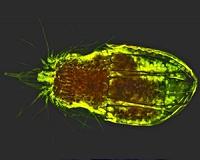| . |  |
. |
Norwich, UK (SPX) Apr 29, 2010 To evolve or not to evolve? That is the question scientists at the University of East Anglia (UEA) are closer to answering following a groundbreaking new study into the colourful hamlet fish. Little is known about the way species evolve in the vast marine environment. The new findings, published online by the journal Global Ecology and Biogeography, significantly improve our understanding of speciation - the evolutionary process by which new species arise. The hamlets are a group of colourful coral reef fish found throughout the Caribbean. Ten species of hamlet have been discovered and each can be easily recognized by its own distinct colour pattern. In some areas, as many as seven varieties can be found on a single reef. However, most hamlet species are only found at specific locations. The blue hamlet, for example, is found only in the Florida region. It had previously been believed that these different species evolved because of geographical separation. For example, it was thought that falling sea levels in the past could have divided the original species. Then, when levels increased, the differently evolved species were thrown back together. The new study by ecologists at UEA and Simon Fraser University in Canada found little evidence for this theory and instead suggests that hamlet colour varieties could have evolved regardless of any physical separation. Using thousands of underwater surveys made by SCUBA divers as part of the REEF volunteer survey project (www.reef.org), the researchers analysed distributions of the ten different hamlet species. They found that even widespread hamlet species are not found everywhere, and identified high density hotspots for each species. Since different species hotspots overlap and many species have more than one hotspot, the results do not support the theory that hamlets originated independently when they were geographically separated in the past. The research also showed how ecological factors, such as competition for food or habitat, may influence how different hamlet species co-exist. "Our findings suggest that ecology may better explain the evolution of hamlets than geographical separation," said lead author Dr Ben Holt of UEA's School of Biological Sciences. "Many scientists believe hamlets are beginning to evolve into a new species and this latest discovery will shed light on this process." 'Signatures of speciation? Distribution and diversity of Hypoplectrus (Teleostei: Serranidae) colour morphotypes' by B Holt (UEA), I Cote (Simon Fraser University, Canada) and B Emerson (UEA) is published by Global Ecology and Biogeography on April 23.
Share This Article With Planet Earth
Related Links University of East Anglia Darwin Today At TerraDaily.com
 Explorers Census Hard-To-See Sea Life
Explorers Census Hard-To-See Sea LifeWashington DC (SPX) Apr 29, 2010 Ocean explorers are puzzling out Nature's purpose behind an astonishing variety of tiny ocean creatures like microbes and zooplankton animals - each perhaps a ticket-holder in life's lottery, awaiting conditions that will allow it to prosper and dominate. The inventory and study of the hardest-to-see sea species - tiny microbes, zooplankton, larvae and burrowers in the sea bed, which toget ... read more |
|
| The content herein, unless otherwise known to be public domain, are Copyright 1995-2010 - SpaceDaily. AFP and UPI Wire Stories are copyright Agence France-Presse and United Press International. ESA Portal Reports are copyright European Space Agency. All NASA sourced material is public domain. Additional copyrights may apply in whole or part to other bona fide parties. Advertising does not imply endorsement,agreement or approval of any opinions, statements or information provided by SpaceDaily on any Web page published or hosted by SpaceDaily. Privacy Statement |